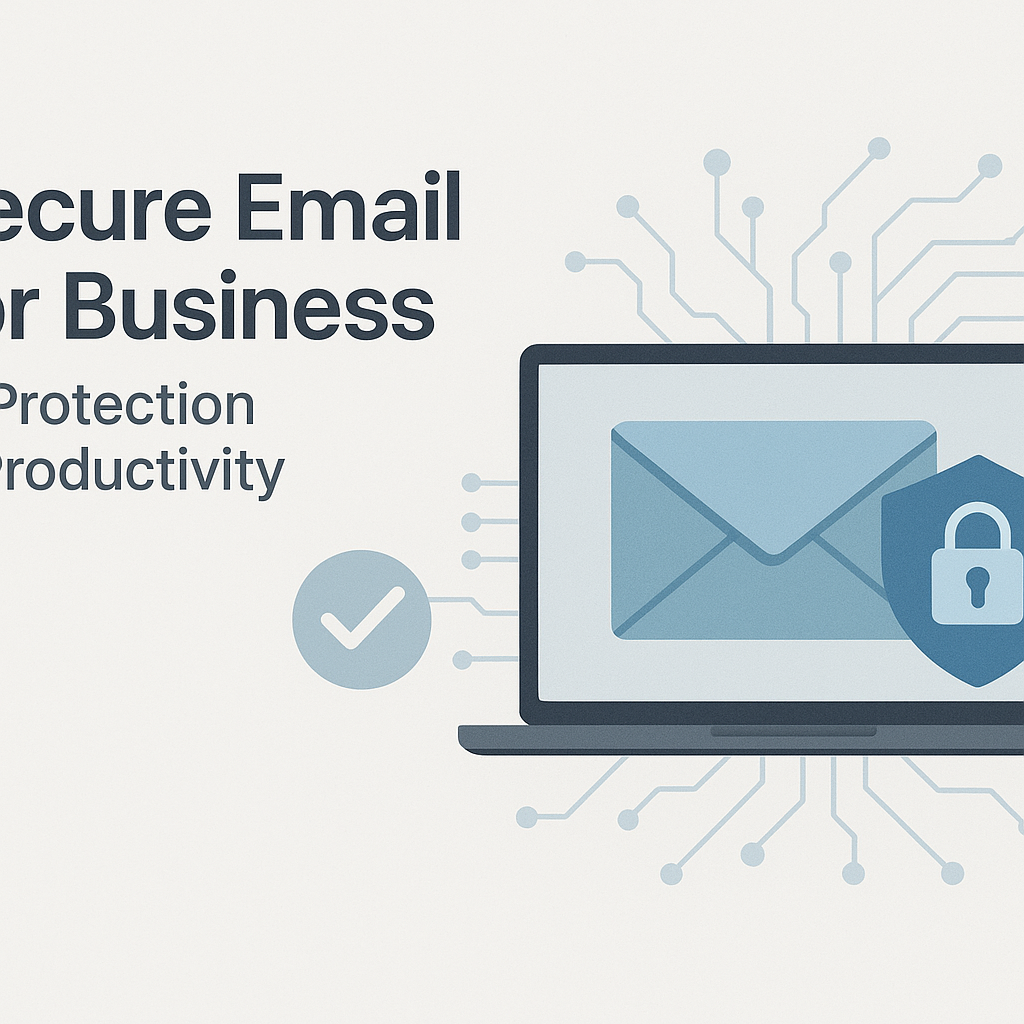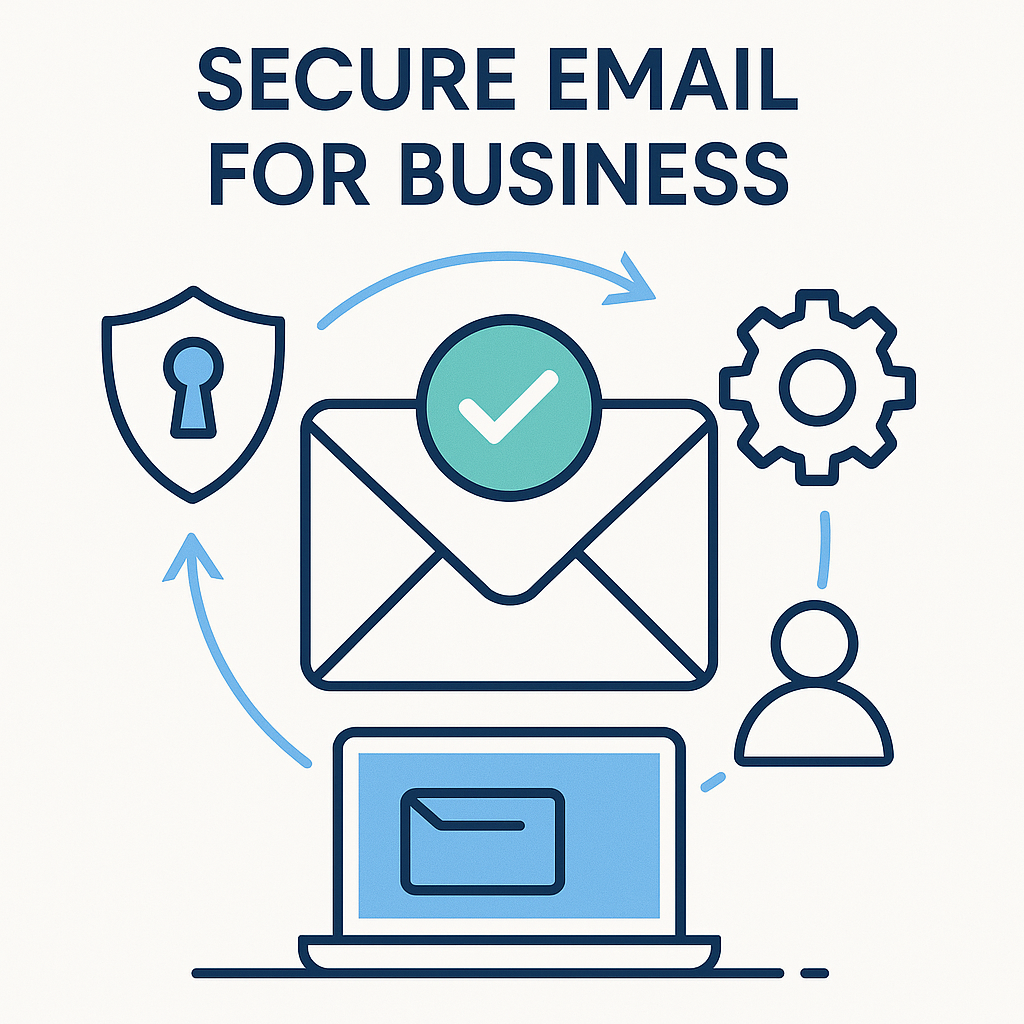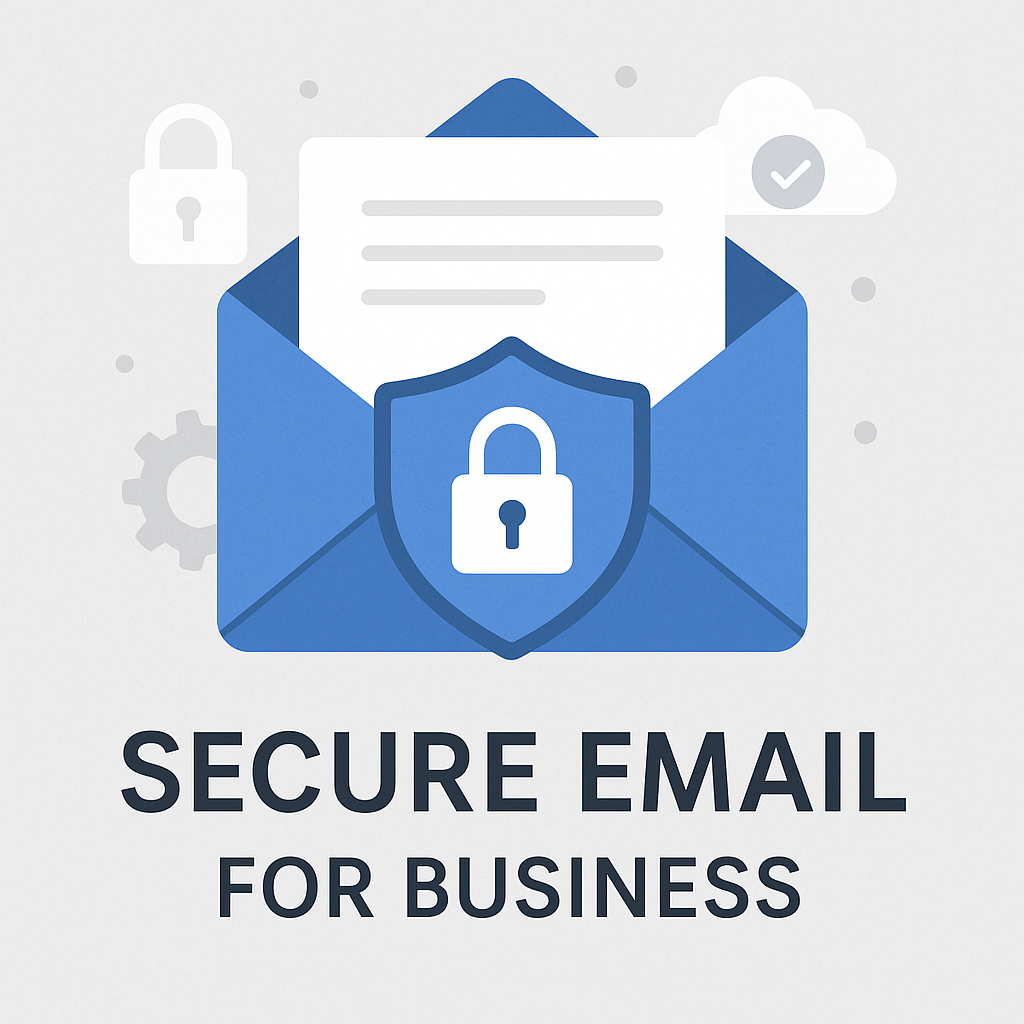Secure Email for Business: AI Protection & Productivity

In today's hyper-connected world, email remains the lifeblood of business communication. From client interactions and internal collaboration to critical data exchange, our inboxes are central to our daily operations. However, this reliance also makes email a prime target for cybercriminals. Implementing robust secure email for business solutions isn't just a best practice; it's a fundamental necessity for protecting sensitive information, maintaining customer trust, and ensuring operational continuity. As threats evolve, so too must our defenses, and the integration of Artificial Intelligence (AI) is rapidly transforming how we achieve both advanced security and enhanced productivity.
This article delves into the critical aspects of securing your business communications, exploring the common threats you face, the essential features of a secure email platform, and the transformative power of AI in safeguarding your digital fortress while streamlining your workflow. We'll guide you through best practices, selection criteria, and the future landscape of email security and productivity.
Understanding the Risks: Why Secure Email is Non-Negotiable for Businesses
Email has evolved from a simple messaging tool to a comprehensive platform for conducting business. Unfortunately, this ubiquity makes it a vast attack surface. Cybercriminals are constantly devising new methods to exploit vulnerabilities, leading to significant risks for organizations of all sizes. Understanding these threats is the first step toward effective prevention.
Common Email-Related Threats
- Phishing and Spear-Phishing: These attacks involve deceptive emails designed to trick recipients into revealing sensitive information (like login credentials or financial details) or downloading malware. Spear-phishing is a more targeted version, often personalized to specific individuals or roles within an organization. The FBI's Internet Crime Complaint Center (IC3) consistently reports phishing and related schemes as the most common cybercrimes, with billions of dollars lost annually.
- Malware and Ransomware: Malicious software can be delivered via email attachments or malicious links. Once executed, it can steal data, disrupt operations, or encrypt files, demanding a ransom for their release. Ransomware attacks, in particular, can cripple businesses, leading to extensive downtime and recovery costs.
- Business Email Compromise (BEC): This sophisticated scam targets businesses by impersonating executives or trusted partners. Attackers often request wire transfers, change payment details, or solicit sensitive employee information, leading to substantial financial losses and internal disruption.
- Data Breaches: Accidental exposure or malicious theft of sensitive customer data, intellectual property, or financial records via email can result in severe legal penalties, hefty fines (e.g., under GDPR), and irreparable damage to brand reputation. Ensuring email data breach prevention is paramount.
- Spoofing: Attackers can forge email headers to make messages appear to originate from a legitimate source, further enhancing the credibility of phishing or malware attempts.
The consequences of a security lapse in business email can be devastating. Beyond immediate financial losses, businesses face reputational damage, loss of customer trust, legal liabilities, and operational paralysis. This underscores why investing in comprehensive business email security is not an option, but a core requirement for survival and growth in the digital age.
Key Features of a Secure Business Email Platform
A truly secure business email solution goes far beyond basic spam filtering. It incorporates multiple layers of protection designed to safeguard communications and sensitive data. When evaluating platforms, look for these essential features:
Essential Security Components
- Robust Encryption: This is fundamental.
- End-to-End Encryption (E2EE): Ensures that only the sender and intended recipient can read the message. Even the service provider cannot access the content. This is critical for highly sensitive communications.
- Transport Layer Security (TLS): Encrypts data in transit between email servers, preventing eavesdropping during delivery. While essential, it doesn't protect the message once it reaches the recipient's inbox.
- Multi-Factor Authentication (MFA): Also known as Two-Factor Authentication (2FA), MFA adds an extra layer of security by requiring users to provide two or more verification factors to gain access to an account. This significantly reduces the risk of unauthorized access even if credentials are compromised.
- Advanced Spam and Malware Filtering: Modern solutions leverage AI and machine learning to detect and block a wider range of threats, including sophisticated phishing attempts, zero-day malware, and malicious links, often before they reach the user's inbox.
- Data Loss Prevention (DLP): DLP policies can identify, monitor, and protect sensitive data (like credit card numbers or personal identification information) from being accidentally or maliciously sent outside the organization.
- Secure Storage and Compliance: Platforms should offer secure, encrypted storage for emails and adhere to relevant data protection regulations such as GDPR, HIPAA, or CCPA, depending on your industry and location. This ensures that your data is handled responsibly and legally.
- User Access Controls and Policies: Granular control over who can access what information, enforce password policies, and manage device access is crucial for maintaining internal security.
- Email Authentication Protocols: Implementing protocols like SPF (Sender Policy Framework), DKIM (DomainKeys Identified Mail), and DMARC (Domain-based Message Authentication, Reporting & Conformance) helps verify the sender's identity and prevent email spoofing, bolstering your phishing protection for business.
Choosing a platform that offers comprehensive encrypted business email capabilities and integrates these features seamlessly is key to building a strong defense against cyber threats.
For those using popular platforms, understanding specific features can be beneficial. For example, learning about encrypting Outlook emails can be a valuable step for many businesses.
How AI Enhances Email Security and Threat Detection
Traditional security measures, while important, often rely on known threat signatures. Artificial Intelligence (AI) and Machine Learning (ML) represent a paradigm shift, enabling email security solutions to move from reactive to proactive and predictive defense.
AI-Powered Threat Intelligence
- Behavioral Analysis: AI algorithms can learn the normal communication patterns within an organization and for individual users. Any deviation from these patterns—such as unusual sending times, recipient lists, or message content—can be flagged as suspicious, even if the threat is novel.
- Natural Language Processing (NLP): NLP allows AI to understand the context, sentiment, and intent behind email content. This is invaluable for detecting subtle phishing cues, urgent requests, or impersonation tactics that keyword filters might miss. It can identify manipulative language, grammatical errors indicative of foreign actors, or suspicious urgency.
- Advanced Malware Detection: AI can analyze file attachments and links for malicious behavior rather than just relying on known virus signatures. This allows for the detection of zero-day threats and polymorphic malware that constantly changes its code to evade traditional detection methods.
- Predictive Analytics: By analyzing vast datasets of past threats and current trends, AI can predict emerging attack vectors and proactively update defenses. This is crucial for staying ahead of evolving cybercriminal strategies.
- Automated Response and Remediation: When a threat is detected, AI can trigger automated responses, such as quarantining suspicious emails, alerting IT administrators, or even blocking communication channels from a compromised source, significantly reducing the window of vulnerability.
The integration of AI into email security platforms provides a more intelligent, adaptive, and robust defense. It's not just about blocking known threats; it's about anticipating and neutralizing unknown ones before they can cause damage. This advanced AI email protection is becoming indispensable for modern businesses.
Implementing Best Practices for Secure Email Communication
Technology is only one part of the equation. Human behavior and established protocols are equally critical in maintaining a secure email environment. A layered approach combining technology with user awareness and policy is the most effective strategy.
Employee Training and Awareness
Your employees are your first line of defense. Regular, engaging training is essential:
- Recognizing Phishing: Educate staff on how to identify suspicious emails, including common red flags like urgent requests, poor grammar, generic greetings, mismatched sender addresses, and suspicious links or attachments.
- Password Hygiene: Enforce strong, unique password policies and encourage the use of password managers.
- MFA Adoption: Make MFA mandatory for all user accounts and provide clear instructions on how to use it.
- Data Handling: Train employees on secure practices for handling sensitive data, including when and how to use encryption and what information should never be transmitted via email.
- Reporting Suspicious Activity: Establish a clear and easy process for employees to report any suspected phishing attempts or security incidents without fear of reprisal.
IT and Policy Measures
- Regular Software Updates: Ensure all email clients, servers, operating systems, and security software are kept up-to-date with the latest patches to fix known vulnerabilities.
- Secure Device Policies: Implement policies for secure use of company-issued and personal devices (BYOD) that access company email. This includes screen lock requirements and remote wipe capabilities.
- Email Authentication: Properly configure SPF, DKIM, and DMARC to protect your domain from spoofing and improve email deliverability.
- Data Backup and Recovery: Regularly back up your email data and test your recovery procedures to ensure business continuity in case of data loss or ransomware attacks.
- Access Management: Regularly review user access permissions, promptly revoking access for departing employees.
By embedding these practices into the daily workflow, businesses can significantly strengthen their business email security posture and reduce the likelihood of an email data breach prevention failure.
Choosing the Right Secure Email Solution for Your Business Needs
Selecting the right secure email platform is a strategic decision that impacts security, productivity, and operational costs. It requires a thorough assessment of your organization's unique requirements.
Key Considerations for Selection
- Assess Your Security and Compliance Needs: What industry regulations (e.g., HIPAA, GDPR, PCI DSS) must you comply with? What types of sensitive data do you handle? Your chosen solution must meet these stringent requirements, often necessitating robust encryption and data handling capabilities.
- Evaluate Feature Set vs. Cost: Compare the security features (encryption, MFA, DLP, threat detection) and productivity enhancements offered by different providers against their pricing models. Look for a balance that provides adequate protection without breaking the budget.
- Integration Capabilities: Does the platform integrate seamlessly with your existing business applications and workflows (e.g., CRM, collaboration tools, calendar)? Good integration reduces friction and enhances adoption. Consider how features like email API integration can extend functionality.
- User Experience and Ease of Use: A complex or cumbersome interface can lead to low adoption rates and frustration. The platform should be intuitive for end-users and easy for IT administrators to manage.
- Scalability and Support: Choose a solution that can grow with your business. Reliable customer support and technical assistance are also crucial, especially when dealing with security issues.
- Reputation and Track Record: Research the provider's history, customer reviews, and security certifications. Look for established providers with a proven commitment to security and privacy.
For instance, platforms like Google Workspace offer advanced AI features integrated across their suite, enhancing both security and productivity. Exploring options that leverage AI for tasks like threat detection and inbox management can lead to significant operational improvements. As noted by Google Workspace themselves, AI Tools for Business are transforming how companies operate.
When evaluating options, consider the broader ecosystem of tools available. Many businesses are exploring a variety of AI productivity tools to streamline operations across departments.
Balancing Security and Productivity with AI-Powered Email Tools
The modern challenge isn't just about securing email; it's about doing so without hindering the speed and efficiency that businesses demand. This is where AI-powered email tools shine, offering a dual benefit of enhanced security and significant productivity gains.
AI for Enhanced Efficiency
AI excels at automating repetitive tasks and providing intelligent assistance, freeing up professionals to focus on higher-value work:
- Inbox Triage and Prioritization: AI can automatically sort emails, identify urgent messages, and flag important conversations, helping users combat email overload solution challenges.
- Smart Replies and Suggestions: AI can suggest quick replies or draft responses based on email content, speeding up communication.
- Automated Scheduling: AI assistants can help find optimal meeting times, send invites, and manage calendars, streamlining the often-tedious process of coordinating schedules.
- Summarization: For lengthy email threads, AI can generate concise summaries, allowing users to quickly grasp the key points without reading every message.
- Proactive Notifications: AI can alert users to potential follow-ups or important deadlines embedded within emails.
By automating these tasks, AI tools help professionals manage their inboxes more effectively, leading to improved email productivity tips and reduced stress. Exploring Outlook AI features can also unlock new levels of efficiency. For example, platforms like Motion are recognized for their ability to manage tasks and schedules using AI.
The Synergy of Security and Productivity
Crucially, these productivity gains do not come at the expense of security. In fact, many AI tools enhance it:
- Smarter Threat Detection: As discussed earlier, AI's ability to analyze patterns and content improves phishing protection for business and malware detection.
- Policy Enforcement: AI can help enforce security policies by flagging emails that violate rules, such as those attempting to send sensitive data unencrypted.
- Streamlined Security Workflows: AI can automate parts of the incident response process, making security management more efficient.
Modern businesses are increasingly turning to advanced tools, including those that act as an ai executive assistant, to manage their complex communication needs securely and efficiently. These platforms aim to bring order to the chaos of the inbox, protect sensitive data, and boost overall operational effectiveness. Platforms like Superhuman, while focusing heavily on speed and user experience, also integrate smart features that contribute to productivity.
The goal is to create an email environment that is both a secure fortress and a highly efficient workspace. This balance is achievable with the right technology and strategy.
The Future of Secure Email: Trends and Innovations
The landscape of email security and productivity is constantly evolving, driven by advancements in technology and the persistent creativity of cyber threats. Staying informed about future trends is vital for maintaining a leading edge.
Emerging Technologies and Concepts
- Advanced AI for Deepfakes and Sophisticated Scams: As AI becomes more accessible, expect to see more sophisticated social engineering attacks, including AI-generated text that mimics specific writing styles or even AI-generated voice or video snippets embedded in emails (though video/voice is less common *in* email itself, the tactics are evolving). AI-powered security will need to counter these with even more advanced detection capabilities.
- Post-Quantum Cryptography: Current encryption methods could potentially be vulnerable to future quantum computers. Research and implementation of post-quantum cryptography will be crucial for long-term data security.
- Zero-Trust Security Models: Shifting from perimeter-based security to a "never trust, always verify" approach means that every user and device attempting to access email resources must be authenticated and authorized, regardless of their location.
- AI for Privacy Enhancement: Beyond security, AI is being explored to enhance user privacy by automatically redacting sensitive information in outgoing emails or anonymizing data for analysis.
- Increased Automation in Threat Hunting: AI will play a larger role in proactively searching for and identifying threats within networks and email systems, rather than just responding to alerts.
- Federated Learning for Security: This AI technique allows models to be trained across multiple decentralized devices or servers holding local data samples, without exchanging the data itself. This could enable more robust security models without compromising user privacy.
These trends suggest a future where email security is more intelligent, adaptive, and integrated, working hand-in-hand with AI to boost user productivity and protect against an ever-more sophisticated threat landscape.
Actionable Steps: Securing Your Business Email Today
Protecting your business email doesn't require a complete overhaul overnight. You can start implementing crucial measures immediately to bolster your defenses and enhance your team's productivity.
Immediate Actions for Better Security and Productivity
- Conduct a Security Audit: Assess your current email security measures, identify vulnerabilities, and understand your organization's risk exposure.
- Implement MFA Universally: Make Multi-Factor Authentication mandatory for all employees and for accessing email accounts. This is one of the single most effective steps you can take.
- Invest in Employee Training: Schedule regular cybersecurity awareness training, focusing on phishing recognition and safe email practices. Make it engaging and ongoing.
- Review Your Email Provider: Evaluate your current email service. Does it offer the necessary security features? Is it scalable? Are you leveraging its full capabilities? Consider upgrading or switching to a more secure and AI-enhanced platform if needed.
- Explore AI-Powered Tools: Look into how AI can help manage your inbox, improve communication efficiency, and bolster security. Tools that offer intelligent sorting, summarization, or advanced threat detection can make a significant difference.
- Strengthen Password Policies: Enforce strong password complexity rules and encourage the use of password managers.
- Configure Email Authentication: Ensure SPF, DKIM, and DMARC records are correctly set up for your domain to prevent spoofing.
By taking these proactive steps, you can significantly improve your secure email for business posture, protect against common threats like phishing, and start reaping the productivity benefits of modern, AI-enhanced communication tools. Prioritizing business email security is an investment in your company's future resilience and success.
Securing your business email is an ongoing commitment, not a one-time fix. By understanding the risks, implementing robust technical safeguards, fostering a culture of security awareness, and leveraging the power of AI, you can create a communication environment that is both highly secure and incredibly productive. Take action today to protect your organization's most valuable asset: its data and its reputation.



